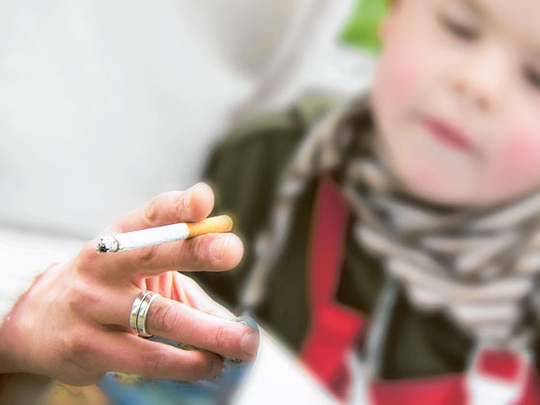
Dubai: Experts stress that the only way parents can combat children’s risk of health complications from exposure to second-hand smoke is to stop lighting up at home.
Senior cardiologists speaking to Gulf News point to a child’s smaller lungs, faster breathing rate and less developed immune system as factors that expose them to greater risk.
Their message is passive smoking is an avoidable risk factor for respiratory symptoms in children.
In response to a study published in international journal Tobacco Control on the dangers of smoking in cars in the presence of children — even with open windows — they said that the dangers of passive smoking apply to homes as well public places.
Figures from WHO suggest that one-third of those killed are children often exposed to second-hand smoke at home.
Speaking to Gulf News, Dr Khalifa Omar Mohammad, cardiologist at Rashid Hospital, said that passive smoking is breathing in smoke from other people’s cigarettes, cigars or pipes.
“Two broad classifications under this are main stream and side stream. The former is smoke breathed out by a smoker, and the latter is smoke from the burning end of a cigarette. Together these contribute to Environmental Tobacco Smoke (ETS). Parental smoking is said to be the most common source of ETS exposure among kids.”
Expounding on the harms associated with exposure to second-hand smoke, Dr Mohammad, said, “In children, prenatal exposure to ETS is linked to impaired lung function and increased risk of developing asthma; whereas postnatal exposure tends to be a trigger for respiratory symptoms and asthma attacks. Children exposed to ETS are more likely to suffer from conditions including pneumonia, bronchitis and asthma.”
He explained that smoke damages the arteries and inner lining of the growing lungs in children, who tend to develop mild airway diseases that could further develop into chronic respiratory conditions.
“ETS has a direct link to learning impairment, sleep disturbances, lack of concentration, irritability and other behavioural problems. In pregnant women, the unborn baby can suffer from intrauterine growth restriction (IUGR) [poor growth of a baby while in the mother’s womb] as a result of less than the required oxygen supply,” he added.
In homes and public spaces, the risks of passive smoking cannot be lessened because children have to be with their parents, and cannot move away from the source of the second-hand smoke, said Dr V. J. Sebastian, consultant cardiologist, head of Cardiology, International Modern Hospital, Dubai. He told Gulf News, “In homes, air cleaners could be used to marginally improve the air quality. However it is only a temporary tool.
“The only way to achieve a smoke-free household is for parents to avoid smoking at home. Parents should also avoid taking their kids to smoke-filled public spaces,” he said.












